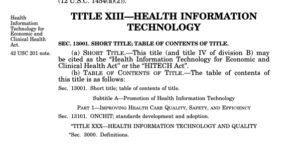Medical Ethics
Medical ethics and biomedical ethics and the Standard of Care regarding: Patient privacy under HIPAA, Hybrid Entities under HIPAA and the Privacy Shield Standard as well as State privacy standards…
Medical ethics and biomedical ethics and the Standard of Care regarding: Patient privacy under HIPAA, Hybrid Entities under HIPAA and the Privacy Shield Standard as well as State privacy standards…
HITECH Act and HIPAA Omnibus Rule HIPAA was enacted in 1996, the ARRA HITECH Act in 2009, the HIPAA Omnibus Rule in 2013. In January 2020, a Federal Court ruled…
In October 2020 and April 2021, the U.S. National Security Administration posted advisories regarding known vulnerabilities that Chinese and Russian hackers use to breach U.S. and other networks. Our Observations:…
Employer Required COVID-19 tests for employees, According to the Americans with Disabilities Act, and EEOC Laws According to the U.S. Equal Employment Opportunity Commission: An employer may administer a COVID-19…
On December 24, 2020 the Senate passed new legislation H.R.7898 - "To amend the Health Information Technology for Economic and Clinical Health Act (HITECH Act) to require the Secretary of…

What is the HITECH Act? An Introduction for the Layperson Money to convert from paper to electronic People who ask, "What is the HITECH Act?" should understand how the Act…
Integrated Medical Bill Review and Subrogation Integrated medical bill review combines silos into one solution. This article provides a summary of various strategies to determine the value of medical bills. Plaintiffs in…

What is OIG Regulatory Guidance in Healthcare? OIG Regulatory Guidance has seven elements and is divided by the healthcare industry sector. The U.S. HHS Office of the Inspector General (OIG)…

MACRA Changes Health Care Economics with a Focus on ChildrenMACRA Background: A final rule released on Oct. 14, 2016 by the Centers for Medicare and Medicaid Services (CMS) details the final…
Precision medicine targets disease at a genetic level for groups of patients with specific attributes. Sharing patient data at the point of care introduces new opportunities and new HIPAA Privacy…
Peyton Manning's privacy was violated by Guyer Institute IF the press is accurately presenting the facts about the patient and the HIPAA covered entity.
by Michael Arrigo In my experience serving as HIPAA Expert Witness on HIPAA Privacy and Security advising clients in HIPAA breach litigation cases, one of the most important and challenging…